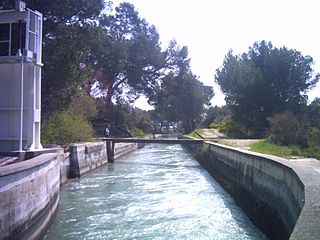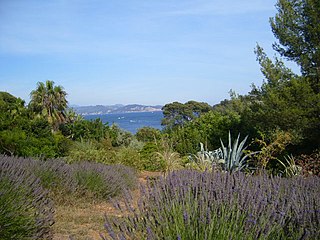 W
WProvence is a geographical region and historical province of southeastern France, which extends from the left bank of the lower Rhône to the west to the Italian border to the east, and is bordered by the Mediterranean Sea to the south. It largely corresponds with the modern administrative region of Provence-Alpes-Côte d'Azur and includes the departments of Var, Bouches-du-Rhône, Alpes-de-Haute-Provence, as well as parts of Alpes-Maritimes and Vaucluse. The largest city of the region is Marseille.
 W
WThe Canal de Marseille is a major source of drinking water for all of Marseille, the largest city in Provence, France. The canal along its main artery is 80 kilometres (50 mi) long but has additional 160 kilometres (99 mi) of minor arteries. Its construction lasted 15 years and was directed by the engineer Franz Mayor de Montricher; the canal opened on July 8, 1849.
 W
WThe County of Forcalquier was a large medieval county in the region of Provence in the Kingdom of Arles, then part of the Holy Roman Empire. It was named after the fortress around which it grew, Forcalquier.
 W
WThe Federalist revolts were uprisings that broke out in various parts of France in the summer of 1793, during the French Revolution. They were prompted by resentments in France's provincial cities about increasing centralisation of power in Paris, and increasing radicalisation of political authority in the hands of the Jacobins. In most of the country the trigger for uprising was the exclusion of the Girondins from the Convention after the Insurrection of 31 May – 2 June 1793. Although they shared common origins and political objectives, the revolts were not centrally organised or well-coordinated. The revolts failed to win any sustained popular support and were put down by the armies of the Convention over the following months. The Reign of Terror was then imposed across France to punish those associated with them and to enforce Jacobin ideology.
 W
WFeria d'Arles is a popular festival centered on bull activities which is held each year in Arles, France.
 W
WThe Festival d'Avignon, or Avignon Festival, is an annual arts festival held in the French city of Avignon every summer in July in the courtyard of the Palais des Papes as well as in other locations of the city. Founded in 1947 by Jean Vilar, it is the oldest existent festival in France and one of the world's greatest. Alongside the official festival, the "In" one, a number of shows are presented in Avignon at the same time of the year and are known as the "Off".
 W
WGallia Narbonensis was a Roman province located in what is now Languedoc and Provence, in southern France. It was also known as Provincia Nostra, from its having been the first Roman province north of the Alps, and as Gallia Transalpina, distinguishing it from Cisalpine Gaul in northern Italy. It became a Roman province in the late 2nd century BC. Its boundaries were roughly defined by the Mediterranean Sea to the south and the Cévennes and Alps to the west and north. The western region of Gallia Narbonensis was known as Septimania.
 W
WThe Gardens of Provence-Alpes-Côte d'Azur is a list and description of the parks and gardens in the region, which are classified by the Committee of Parks and Gardens of the French Ministry of Culture as among the Notable Gardens of France.
 W
WThe Jardin de l'alchimiste is a private contemporary garden in the town of Eygalières, in the Bouches-du-Rhône Department of France. It is classified by the French Ministry of Culture as one of the Remarkable Gardens of France.
 W
WThe Jardin de la Magalone is public park and garden à la française in the city of Marseille, France. It is listed by the French Ministry of Culture as one of the Remarkable Gardens of France.
 W
WThe levant is an easterly wind that blows in the western Mediterranean Sea and southern France, an example of mountain-gap wind. In Roussillon it is called "llevant" and in Corsica "levante". In the western Mediterranean, particularly when the wind blows through the Strait of Gibraltar, it is called the Viento de Levante or the Levanter. It is also known as the Solano.
 W
WMiss Provence is the beauty pageant responsible for selecting Provence's representative to Miss France pageant.
 W
WThe mistral is a strong, cold, northwesterly wind that blows from southern France into the Gulf of Lion in the northern Mediterranean. It produces sustained winds often exceeding 66 km/h (41 mph) / 18 m/s (36 kn), sometimes reaching 185 km/h (115 mph) / 51 m/s (100 kn). It is most common in the winter and spring, and strongest in the transition between the two seasons. Periods of the wind exceeding 30 km/h (19 mph) / 8 m/s (16 kn) for more than sixty-five hours have been reported.
 W
WThe National Liberation Front of Provence,, is a militant nationalist group that advocates an independent state of Provence and secession from France.
 W
WNemfidius was Patriarch of Provence around 700 CE, during the time of Pepin of Herstal (687-714). He was succeeded by Antenor. Nemfidius issued coins, some of which have reached us.
 W
WParc Borély is a public municipal park in the city of Marseille, France. It is classified by the Ministry of Culture as one of the Remarkable Gardens of France. The park is 17 hectares in size. It adjoins the Jardin botanique E.M. Heckel.
 W
WThe Parc du 26e Centenaire is a public park located in the 8th arrondissement of Marseille, France. It is listed by the French Ministry of Culture as one of the Remarkable Gardens of France.
 W
WPétanque is a sport that falls into the category of boules sports, along with raffa, bocce, boule lyonnaise, lawn bowls and crown green bowling. In all of these sports, players or teams play their boules/balls towards a target ball.
 W
WA gibassier is a French pastry from Provence, a galette made with fruited olive oil. It is generally spiced with anise, candied orange peel, and orange flower water, and dusted with baker's sugar.
 W
WProvençal markets or markets of Provence have become one of the regional emblems of Provence-Alpes-Côte d'Azur. Traditional markets held in a town or village are events that are both a celebration of local identity, and a collective ceremony in which everyone is both the participant and spectator, as well as a meeting place where everyone is equal and no one is excluded.
 W
WThe Provence Donkey, French: Âne de Provence, is a breed of domestic donkey from Provence, in south-eastern France. It is now distributed through much of central and south-east France, with the highest concentration in Provence and the Rhône-Alpes region. For hundreds of years the Provence donkey was used by transhumant shepherds of the area as a pack animal in the seasonal movement of flocks of sheep between their summer pastures on the high Alps of Haute-Provence and the Dauphiné and their winter grounds in Basse-Provence.
 W
WMiel de Provence is protected by a Label Rouge associated to a protected geographical indication both for the all flowers honey and for the lavender and lavandin honey
 W
WProvence Rugby is a French rugby union club currently playing in Rugby Pro D2, the second tier of France's league system. They were promoted back to the second level for the 2018–19 season after 2 seasons in Fédérale 1.
 W
WProvence (Provençal) wine comes from the French wine-producing region of Provence in southeast France. The Romans called the area provincia nostra, giving the region its name. Just south of the Alps, it was the first Roman province outside Italy.
 W
WThe land of Provence has a history quite separate from that of any of the larger nations of Europe. Its independent existence has its origins in the frontier nature of the dukedom in Merovingian Gaul. In this position, influenced and affected by several different cultures on different sides, the Provençals maintained a unity which was reinforced when it was created a separate kingdom in the Carolingian decline of the later ninth century. Provence was eventually joined to the other Burgundian kingdom, but it remained ruled by its own powerful, and largely independent, counts.
 W
WThe House of the Saboulin Bollena is one of the oldest French aristocratic families, from the old feudal nobility of Provence.
 W
WSantons are small hand-painted terracotta nativity scene figurines produced in the Provence region of southeastern France. In a traditional Provençal crèche, there are 55 individual figures representing various characters from Provençal village life such as the scissors grinder, the fishwife, the blind man, and the chestnut seller.
 W
WThe winds of Provence, the region of southeast France along the Mediterranean from the Alps to the mouth of the Rhone River, are an important feature of Provençal life, and each one has a traditional local name, in the Provençal language.